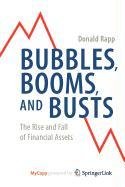Artículos relacionados a Bubbles, Booms, and Busts

This book provides a thorough explanation of the nature and history of booms, bubbles and busts in financial markets. The first part of the book deals with financial booms and bubbles and how they emerge, develop and collapse. It describes the distribution of wealth, inflation, rationality of bankers, monetary and fiscal policy, the role of central banks, tax policies, social security, US federal, state, municipal and personal debt, and valuation of common stocks.
The book describes historical boom/bust cycles including bubbles of the 1720s, the Florida land boom and the stock market in the 1920s, the depression of the 1930s, the S&L scandal of the 1980s, the great bull market of 1982-1995, the crash of 1987, the dot.com mania of 1995-2000, corporate swindles of the 1990s and 2000s, the sub-prime fiasco of the 2000s, and Japan in the late 20th century.
Most of the recent wealth generation has derived from increased debt and appreciation of paper assets. The architects of the new economics were Ronald Reagan and Arthur Greenspan. Inevitably, the US Government's cure for excessive spending and inadequate revenues is to increase spending and cut revenues. American voters must choose between "tax and spend" Democrats and "spend and borrow" Republicans. The theme of American finance was uttered by VP Cheney: "Deficits don't matter".
"Sinopsis" puede pertenecer a otra edición de este libro.
This book deals at some length with the question: Since there are many more poor than rich, why don’t the poor just tax the rich heavily and reduce the inequality? In the 19th century and the first half of the 20th century, the topic of inequality was discussed widely. Ending or reducing inequality was a prime motivating factor in the emergence of communism and socialism. The book discusses why later in the 20th century, inequality has faded out as an issue. Extensive tables and graphs of data are presented showing the extent of inequality in America, as well as globally. It is shown that a combination of low taxes on capital gains contributed to a series of real estate and stock bubbles that provided great wealth to the top tiers, while real income for average workers stagnated. Improved commercial efficiency due to computers, electronics, the Internet and fast transport allowed production and distribution with fewer workers, just as the advent of electrification, mechanization, production lines, vehicles and trains in the 1920s and 1930s produced the same stagnating effect.
"Sobre este título" puede pertenecer a otra edición de este libro.
- EditorialSpringer
- Año de publicación2009
- ISBN 10 0387876472
- ISBN 13 9780387876474
- EncuadernaciónPerfect Paperback
- Número de páginas294
(Ningún ejemplar disponible)
Buscar: Crear una peticiónSi conoce el autor y el título del libro pero no lo encuentra en IberLibro, nosotros podemos buscarlo por usted e informarle por e-mail en cuanto el libro esté disponible en nuestras páginas web.
Crear una petición
